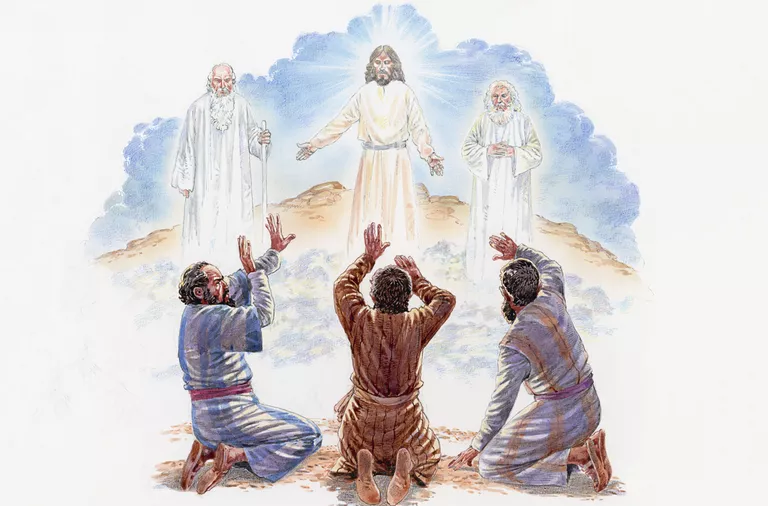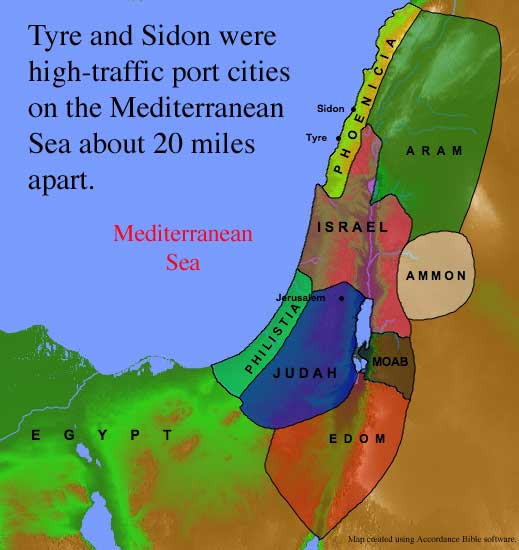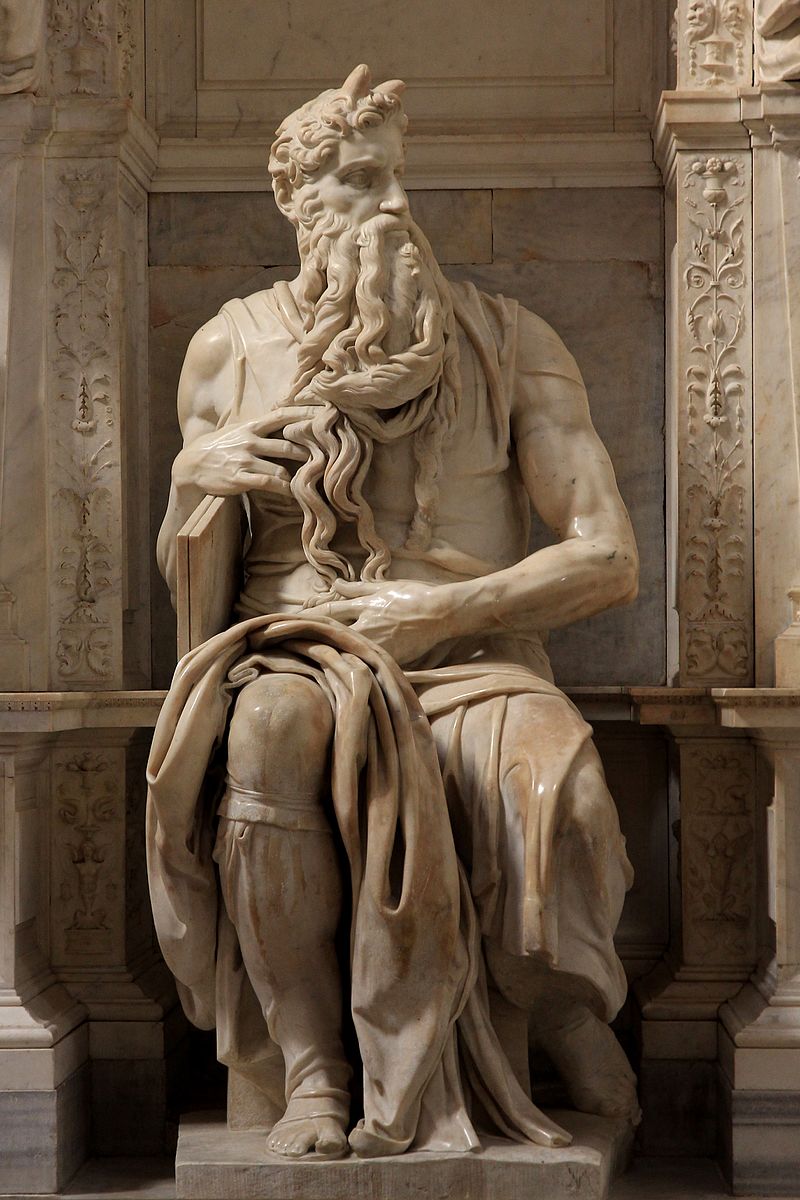Today in the Gospel Reading (Mk 9:2-10) we hear of the Transfiguration of Jesus. Matthew (Mt 17:1 -8) and Luke (Lk 9:28-36) also have accounts of the Transfiguration event, and all three follow the same pattern:
Transfiguration event, and all three follow the same pattern:
- Jesus takes Peter, James and John up a (high) mountain
- There Jesus was transfigured (Mt 17:2 & Mk 9:2) or as Luke record, the ‘appearance’ of Jesus’ ‘face’ changed (Lk 9:29)
- Each record that Jesus’ clothes were ‘dazzling white’
- Moses and Elijah join Jesus and ‘talk’ with him
- Peter offers to build three tents
- A cloud overshadows them
- From the cloud comes a voice saying “This is my Son, the Beloved; listen to Him!” [Matthew adds “with him I am well pleased” (Mt 17:5)]
- The cloud lifts and Jesus is alone.
We are, or should be, familiar with this voice, as we first encountered it at the Baptism of Jesus back in the early stages of each of the synoptics (Mt 3:13-17; Mk 1:9-11; Lk 3:21-22).[1] Here the voice refers to Jesus as Son and Beloved, and in whom voice from heaven was “well pleased”. What we find here is a development in the voice’s instruction that includes: “listen to him!” Clearly as we have advanced through the Jesus story, and our understanding of him has deepened, so must our response to Jesus develop and deepen as well. We must attend to what he says.
Of course, there are many reflections and lines of thought to be taken from the Transfiguration accounts, may I leave you with three.
- The Transfiguration of the Lord reminds us that just as the disciples’ understanding and appreciation of Jesus grew and developed, so must as ours. In some ways, at times, I feel we are a little short-changed in our understanding and appreciation of Jesus, because we know the whole story, and the ‘surprise’ element that must have been the experience of the disciples as they came to know Jesus we are somewhat ‘robbed’ of. Conversely, our knowing the story from beginning to end as we progressively read through the Gospels should allow us to have a certain anticipation as we say to ourselves: “We know what’s happening next!”. Whatever our circumstance – all knowing, or responding to surprise – our relationship with the Risen needs to grow and develop.
- The Transfiguration of the Lord reminds us of the divinity of Jesus. Jesus is (much) more than ‘our mate’, much more than someone who articulated the good way of living. We must be drawn to more than the ‘Jesus project’. The God of Universe breaks into the human history in an unprecedented way in the life of Jesus. The ‘friendship’ we come to know in Jesus is a ‘friendship’ with the Holy (Holiest) One, and so we should embrace it, but with a certain reverential fear and awe. Jesus was not just a ‘nice bloke’!
- Peter, James and John’s experience of the Divine in the Transfiguration of the Lord can be likened to our experiences of God. Perhaps these experiences, these rich moments of insights (mountains experiences one could say), are not long lingering, but that grab us for moment and then are gone; the result of the experience colouring the rest of our days. Whilst we might want to grab hold of and keep these moments – build a tent – often the nature of our experience is that this is not an option for us. So, let us savour these moments, so that when we come down from the mountain, the plain on which we live is transformed.
[1] John’s Gospel has its own recount of the Baptism of Jesus (Jn 1:29-34) but its focus/nuance is different, for example, we find a reference to the Spirit descending on Jesus but no mention a voice.
Image downloaded from https://www.learnreligions.com/transfiguration-bible-story-summary-700068 on 03 August, 2021.
 Link to today’s readings: https://bible.usccb.org/bible/readings/080421.cfm
Link to today’s readings: https://bible.usccb.org/bible/readings/080421.cfm
Today’s Gospel Reading (Mt 15:21-28) which can at first glance seem a little harsh at times, and one of these readings we would rather Matthew left out of his gospel, is in fact one that should bring us great consolation and joy. It actually points to the reality that the message and saving action of Jesus is intended not only for the Jewish people, but also the Gentiles (that’s us!), and also to the power of prayer.
Firstly, in the geography of the Middle East at the time of Jesus, Tyre and Sidon
were considered pagan territories to the northwest of Jewish territory. In Matthew’s account of this event (Mark has his own account – Mk 7:24-30) it is not clear that Jesus has arrived in the area of Tyre and Sidon. The Greek word used is eis, which indicates that it was in the direction of this place that he was heading, not that he had arrived. So, if we are to picture this event, it would involve a pagan woman (a Gentile) coming over into Jewish territory to seek Jesus’ assistance.
At the time of Jesus, biblical and traditional belief was that salvation would come to the world through the People of Israel. So, we have in this narrative – almost in the form of moving pictures – that very belief coming to fulfillment: ‘The God of Israel is approached by Gentiles through Jesus the Jew’.[1] This circumstance helps us understand the verbal tussle that seems to take place between Jesus and the woman. The outcome is that faith, and not ethnicity, wins through: “Woman, great is your faith! Let it be done for you as you wish” (Mt 15:28). That is indeed happy news for us (as Gentiles).
Secondly, we see here the result of the woman’s firm and faithful petitioning of Jesus. This was not the equivalent of a ‘one off shot’, the equivalent of ‘rubbing a lucky rabbit’s foot’, but instead the result of a continued prayerful repêchage by the mother on behalf of her daughter.[2] That we can understand this as ‘prayerful’ is based on the posture taken by the mother before Jesus – ‘she came and knelt before him’ (Mt 15:25).
Let us take some joy then in appreciating the universal nature of the offer of salvation and divine relationship offered us in Jesus, and may today’s Gospel Reading also spur us on to pray faithfully and continually for all that we need.
[1] Harrington, D.J. (1991). Sacra Pagina: The Gospel of Matthew (D.J. Harrington, Ed.). The Liturgical Press, p. 238.
Graphic downloaded from http://www.bibletrack.org/notes/image/Tyre-Sidon.jpg on 29 July, 2021.
[2] You will have to forgive the use of the word ‘repêchage’, but it is the Olympics so I thought it worth a shot.
Link to today’s readings: https://bible.usccb.org/bible/readings/080221.cfm
Today’s Reading from the Gospel of Matthew (14:13-21) has parallels in each of the other three Gospels (Mk 6:30-44; Lk 9:10-17, and Jn 6:1-15). In scripture circles we get quite excited about occasions such as this, as it is referred to as ‘multiple attestation’ which gives us greater confidence in the historical basis of the narratives. No more time needs to be spent on thinking about this unless you are completing an essay in biblical studies somewhere, so I shan’t drone on.
In each of Matthew, Mark and Luke the ‘feeding of the five thousand’ is preceded by the death of St John the Baptist. Matthew and Mark locate the feeding in a ‘deserted place’, while Luke locates his account in a private place near the city of Bethseda. The timing and locations are not accidental, but give us a rich insight in the meaning of the narrative.
Matthew uses the term erémos, a word related to the term for ‘desert’, an image we are familiar with from the First Reading (Numbers 11:4-15) where he hear of the people of Israel being fed with manna in the desert. The 1st century Jewish ear, the community for whom Matthew is writing, would immediately prick-up to this term and so appreciate its nuance/foundation for the present narrative. The people of Israel recently escaped from Egypt find themselves in a deserted place without enough to sustain them, and God provides. In Matthew’s account, the ‘crowds that followed him on foot from the towns’ also find themselves away from the familiar, and are without enough to sustain them, and once again God provides. While the ‘location’ of the feeding is important for the theological insight we again in the person of Jesus, and the inbreaking of the Kingdom of Heaven (a Matthean term), the temporal location of the narrative is also important.
In each of Matthew, Mark and Luke, the feeding of the five thousand is preceded by the beheading of John the Baptist. King Herod hosts a lavish banquet for the rich and powerful, then ends in the (malicious) death of another – St John the Baptist. In contrast, the banquet provided by Jesus, to those who do not have enough, and which ends with food aplenty is a celebration of sharing, is a celebration of common humanity and life.
In all four of the Gospel accounts (Mt 14:17; Mk 6:37, Lk 9:113, and Jn 6:5) we found the disciples doubting / questioning what is that Jesus intends (can?) do here. Whether it is the lack of resources, or the lateness of the day, or the cost of buying food, there is a hesitation on the part of the disciples – a doubt/hesitation that is smashed by what Jesus accomplishes.
The motif of the Kingdom of Heaven / Kingdom of God as being a banquet is deeply entrenched in the Jewish literature, and so would be familiar to Matthew’s readers. May we, in these difficult times, be open to the God of Plenty who seeks to nourish and feed us, even the desert moments and parts of our lives, in ways and times we may not expect but can only be gratefully surprised in.
Link to today’s readings: https://bible.usccb.org/bible/readings/073021.cfm
Today’s Reading from the Gospel of Matthew (13:53-58) has a close parallel in Mark’s Gospel (Mk 6:1-6a). Each locate the narrative in the synagogue of Jesus ‘hometown’. In each people were ‘astounded’ by his ‘wisdom’ and ‘deeds of power’. In each account the people of Jesus’ hometown ‘took offense at him’. This offense seems to find it origins in their inability to accept that someone known to them, someone whose family and childhood they were familiar with, could the source of such wisdom and power.[1] In Matthew’s account (v. 55) it is asked “Is this not the carpenter’s son? Is not his mother called Mary?”, whereas in Mark (v. 3) they ask “Is not this the carpenter, the son of Mary?” The Markan question has a strong element of insult in it, as it would have been more usual to refer to someone by reference to their father rather than mother, and so it seems that Matthew softens the question somewhat.
In both accounts Jesus either ‘did not do many deeds of power’ (Mt 13:58) or ‘could do no deed of power’ (Mk 6:5), and responds with the line: “Prophets are not without honor, except in their country and in their own house” (Mt 13:57) or “Prophets are not without honor except in their hometown, and among their own kin, and in their own house” (Mk 6:4). The people’s lack of belief serves as a barrier to the great inbreaking of the reign of God in that place, at that time.
Luke’s Gospel (Lk 4:16-30) has a more developed recount of this incident. His account too takes place in the synagogue of Jesus’ hometown (Nazareth [Lk 4:16]), and in this case the community are ‘astonished’ by the words of grace that came from his lips’ (Lk 16:22). As with Matthew and Mark the locals question how this can be when they ask: “Is this not the son of Joseph?” (Lk 4:23). Luke includes in his narrative, Jesus outlining his saving mission (“The spirit of the Lord is upon me, for he has anointed me to bring good news to the poor…to proclaim a year of the Lord’s favour” [Lk 4:15]), and also quite a robust rebuttal by him (Jesus) to the doubt expressed by the community. The synagogue community in response are ‘enraged’, and hustle Jesus to a hill, where they intend to throw him off!!
There are many lines of reflection we might be taken along by today’s Gospel, may I offer just one. That unlike the people of Jesus’ hometown, may we not be blinded to, but rather always open to, the presence of the Divine in the familiar and the everyday.
[1] For us who know the end of the story, our amazement at their offense possibly holds the question: “But couldn’t you see or feel God’s great presence in this moment?”
 You may be aware of Michelangelo’s statue of Moses that can be found in the Basilica of St Peter in Chains on the Oppian Hill in Rome. As you look closely at the statue, or in this case the image of the statue, you will see that Moses has horns coming out of his head. This statue, and other similar images of Moses, are often referred to as: Moses with horns. The origin of this particular image of Moses comes from today’s First Reading (Ex 34:29-35).
You may be aware of Michelangelo’s statue of Moses that can be found in the Basilica of St Peter in Chains on the Oppian Hill in Rome. As you look closely at the statue, or in this case the image of the statue, you will see that Moses has horns coming out of his head. This statue, and other similar images of Moses, are often referred to as: Moses with horns. The origin of this particular image of Moses comes from today’s First Reading (Ex 34:29-35).
When St Jerome was translating from the Hebrew into the Latin he took the Hebrew word qāran to me ‘horns’. This was not in itself unusual, as the root-word qāran comes from the word qeren which often, but not always, means ‘horns’. Current biblical scholarship would suggest that a better translation is that of ‘radiant’ or ‘glorified’. We need not spill any further ink here on which of these terms is best, instead we can simply move with the language of the Lectionary: ‘his face was radiant’.
Our First Reading comes from towards the end of Book of Exodus - in fact, we have only chapters 35 to 40 remaining – and it is here that we find a change in the countenance of Moses. The man we first meet as a baby placed in the river (Ex 2:1), who encounters the Divine on Horeb (Ex 3:1-22), who leads the Hebrews out of Egypt (Ex 12 – 15), who with the Hebrew People enters into a Covenant with God and receives (for the first time) the Ten Commandments (Ex 19 - 20: 1-17), and now nearing the end of his life, experiences / shows this radiance in/coming from his face. What is it that has caused this change? It is nothing short of the impact / influence / result of Moses’ continued intimate contact with the Divine. It has, over time, transformed the man.
Our Responsorial Psalm gives us some further insight into the First Reading: ‘Holy is the Lord our God’…’Extol the Lord, our God, and worship at his holy mountain; for holy is the Lord, our God.’[1] It is the absolutely ‘otherness of God’, his ‘holiness’, that has transformed the face of Moses. While God certainly drew near to people of Israel, and did so most fully and uniquely in the person of Jesus, alerting us to the closeness of our God, our First Reading today reminds us not to reduce this closeness simply imagining God as our mate.
It is the closeness of Holiest One that transforms the countenance of Moses, and we hope, in time, might do the same in us.
[1] In fact, as the Responsorial Psalm is (funnily enough) our ‘response’ to the First Reading, if ever you are a little lost as to what to make of the First Reading, reflect upon it in light of the Responsorial Psalm.
Image downloaded from 'Moses' by Michelangelo JBU160 - Moses (Michelangelo) - Wikipedia on 22 July, 2021.
Today’s Gospel Reading (Mt 13:31-35) continues the Parables of the Kingdom we began Wednesday of last week when we started with Mt 13:1-9. In this chapter from Matthew’s Gospel we find we six parables regarding the Kingdom:
- Parable of the Sower (13:4-9),
- Parable of the Darnel (13:24-30),
- Parable of the Mustard Seed (13:31-32),
- Parable of the Yeast (13:33-35),
- Parable of the Hidden Treasure and the Pearl (13:44-46), and
- Parable of the Dragnet (13:47-50).
Today’s Gospel Reading being the parables of the ‘mustard seed’ and the ‘yeast’.
Interestingly, in these parables, Matthew uses the phrase ‘kingdom of heaven’ rather than ‘kingdom of God’, which is the phrase used in the Markan and Lukan accounts. Commentators suggest this difference is in deference to the reverence the Jewish faith has for the divine name. Across the three synoptics though, we are reading about, and reflection upon, the same concern – What is it the impact/influence of the Kingdom will be like.
Often, parables are presented as the means of, or paradigm for, teaching the common folk; however, they are much richer than that. The scripture scholar C.H.Dodd provides the following definition of a parable that, hopefully, allows is to enter more deeply into the richness they offer: ‘a metaphor or simile drawn from nature and common life, arresting the hearer by its vividness or strangeness, and leaving the mind in sufficient doubt of it precise application to tease it into active thought’.[1]
Taking this understanding then, we see the parables as stepping-off points. The familiar, the daily, the common place, are taken as opportunities to lead us into a richer understanding of the experience of God. And, consequently, the familiar, the daily, and the common place, are given a new and richer being themselves.
Today we find two common-place images – mustard seeds and yeast – that serve as windows into the nature and impact of the Kingdom. Both, either small themselves, or used in small amounts, are used here to demonstrate (open the doorway into active thought) the impact of the Kingdom. The active presence of true faith, which opens the door to the Kingdom in our world, can achieve great effects.
Pray to be mustard seeds and faith in our world.
[1] Harrington, D.J. (1991). Sacra Pagina: The Gospel of Matthew (D.J. Harrington, Ed.). The Liturgical Press, p. 198.
 Remembering your faith community in your Will
Remembering your faith community in your Will
After providing for family members in your Will, have you ever considered leaving a bequest directly to your local parish? This is called a legacy or bequest.
Over the years, many people who have felt a special connection with their local parish and Church have left part of their Estate to their Parish. Like a gift to a charity, a bequest
of any amount to the Church is a way of saying “thank you” for the spiritual nurturing provided to you and your family over the years.
Your Parish
Many of us have a special connection to our parish, nurtured by years of faith-sharing, schooling, friendships, and support.
A bequest to your parish, no matter how small, will help the faith community which has meant so much to you to continue its good works and its loving outreach. It is also a
means by which you can plan a lasting gift for your parish which might not be possible in your lifetime.
In receiving a bequest, a parish may be able to use the gift to attend to much-needed maintenance and improvements to the church and other Parish property or put the gift
towards building a new church or refurbishing their existing one. These kinds of gifts help the Parish free up other income to use toward pastoral care programs.
Lumen Christi Catholic Parish
The need for material and spiritual assistance provided by the parish is always growing.
One of the many areas of need is to provide financial support in the ongoing operational cost.
No matter the size of the gift, a bequest of any kind in your Will can make a significant difference.
Your Gift
The following are some examples of how a bequest may be given:
-A Specific Bequest: A detailed gift, for example, an item of property, shares or an insurance policy
-Percentage of your Estate: Nominating a set percentage of your Estate for your chosen beneficiaries
-Residuary Bequest: Nominating a beneficiary to receive any leftover monies from your Estate
-Whole Estate: Nominating your entire Estate for your chosen beneficiary
Would you like to know more?
If you would like to know more about how to remember your Parish in your Will, please contact the parish office on (02) 4211 0500 or email This email address is being protected from spambots. You need JavaScript enabled to view it.. You can be assured that all enquiries are treated with the strictest confidence.







